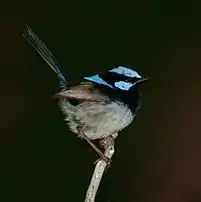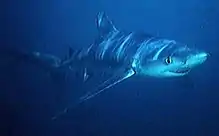Matutinal
Matutinal, matinal (in entomological writings),[1][2] and matutine are terms used in the life sciences to indicate something of, relating to, or occurring in the early morning. The term may describe crepuscular animals that are significantly active during the predawn or early morning hours. During the morning twilight period and shortly thereafter, these animals partake in important tasks, such as scanning for mates, mating, and foraging.[3][4][5]
.jpg.webp)
Matutinal behaviour is thought to be adaptive because there may be less competition between species, and sometimes even a higher prevalence of food during these hours.[6] It may also serve as an anti-predator adaptation by allowing animals to sit between the brink of danger that may come with nocturnal and diurnal activity.[4][7]
Etymology
| Look up matutinal in Wiktionary, the free dictionary. |
The etymology of the term matutinal is the Latin word mātūtīnus, ('of or pertaining to the morning') (from Mātūta, Roman goddess of the dawn + -īnus, '-ine') + -ālis, ('-al').[8]
Adaptive Relevance
Selection pressures, such as high predatory activity or low food may require animals to change their behaviours to adapt. An animal changing the time of day at which it carries out significant tasks (e.g., mating and/or foraging) is recognized as one of these adaptive behaviours. For example, human activity, which is more predominant during daylight hours, has forced certain species (most often larger mammals) living in urban areas to shift their schedules to crepuscular ones.[7] When observed in environments where there is little or no human activity, these same species often do not exhibit this temporal shift.[7] It may be argued that if the goal is to avoid human activity, or any other diurnal predator's activity, a nocturnal schedule would be safer. However, many of these animals depend on sight, so a matutinal or crepuscular schedule is especially advantageous as it allows animals to both avoid predation, and have sufficient light to mate and forage.[4]
Matutinal Mating
For certain species, commencing mating during the early morning's twilight period may be adaptive because it could reduce the risk of predation, increase the chance of finding mates, and reduce competition for mates, all of which may increase reproductive success.[4][9][10]
3.jpg.webp)
Anti-Predatory Adaptation
Animals are generally more vulnerable during copulation (e.g., praying mantis), so mating during a time when there is less predatory activity may be an anti-predatory adaptation.[4] Some species may even take up to several hours to finish mating, which increases this vulnerability.[3][11] For species that copulate for longer periods, shifting their mating schedule may additionally allow enough time for the male to completely inseminate the female (i.e., it will reduce the chance of having to escape from a predator mid-copulation). One example of a matutinal mating routine is exhibited by female tropical praying mantises (Mantis religiosa).[4] To avoid detection from predators they use different stances to blend in with their environment. They can orient themselves to look like leaves or sticks. However, when females are ready to mate they will take up a different posture where they expose pheromone-emitting glands that attract mates, and in the process must disengage from their normal camouflaging stance. Likely to compensate for this vulnerability, females will initiate this stance only at first light when diurnal predators that are visual hunters are less active (e.g., birds and insectivorous primates).[4]
Reduced Competition

Some animals engage in matutinal searching flights to find mates early in the morning. It is thought that this is adaptive because it increases the chance of finding mates, and reduces competition for mates (i.e., by flying directly to a potential mate before it has a chance to find other mates). This is supported by the mating behaviour of certain socially monogamous birds. For example, female superb fairywrens (Malurus cyaneus), are a monogamous bird that perform extra-pair copulations during matutinal hours.[12] One explanation for the prevalence of extra-pair copulation is that it enhances the gene pool of the species' offspring.[13] This activity is most often seen matutinally because they: (1) can avoid being followed by their monogamous partner in the dimly-lit early morning, (2) males are more likely to be present in their territory during these hours, and (3) males are more likely to have a higher quantity of sperm in the early morning.[9][10] These points may apply to how matutinal mating is adaptive in other species.
Similar behaviours have been observed in other species, such as in males of two species of dragonflies (Aeshna grandis & Aeshna viridis).[3][11] They engage in matutinal searching flights each morning until they find a receptive female to mate with. A similar phenomenon is seen in male praying mantises, where they respond to the emerging light each morning by increasing flight activity.[4]
Matutinal Foraging
Some animals exhibit increased foraging behaviour during the matutinal hours. Some examples of why this may be adaptive are: (1) it may increase predatory success and (2) competition for food may be reduced.[5][6]

Predatory Adaptation
The blue shark (Prionace glauca) is a predator that primarily hunts during the pre-dawn to dawn period.[5] During matutinal hours, they spend more time than any other point in the day at the surface of the ocean.[5] It is likely that they are taking advantage of the increased density of prey at the water's surface during dawn.[6] It is also possible that, since only a thin layer at the surface of the ocean is dimly lit during this twilight period, the shark (coming up from the dark ocean depths) has vision of the prey, but the prey do not have vision of the shark, allowing the shark to sneak up on the prey, increasing predatory success.[6][14]
Reduced Competition
Some bees (e.g., Ptiloglossa arizonensis, Pt. jonesi, Caupolicana, and Hemihalictus lustrans) forage matutinally, possibly because there is less competition for food during this period.[1][2] The Hemihalictus lustrans, for example, is a bee that works mutualistically with the dandellion Pyrrhopappus carolinianus during matutinal hours.[1] Pyrrhopappus carolinianus flowers very early in the morning and Hemihalictus lustrans begins foraging at the same time. The bee tears open the dandellion's anthers just as it is flowering, which speeds up anthesis and ensures that it almost always has first claim to the dandellion's pollen.[1]
Physiological Evidence of Adaptation
These matutinal behaviours may be induced by physiological adaptations. Robinson & Robinson[4] reversed the day-night schedule of female tropical praying mantises (i.e., by placing them in light during the night, and in a chamber with no light during the day). After they adjusted to the schedule, the praying mantises were removed from their chambers at different times throughout the newly adjusted night period and placed in the light. Each praying mantis initiated their pheromone-emitting stance during this transition regardless of the time, which suggests that this behaviour depends solely on the transition from dark to light. The authors suggested that this was likely a physiological adaptation.[4]
References
- Estes, James R.; Thorp, Robbin W. (1975). "Pollination Ecology of Pyrrhopappus carolinianus (Compositae)". American Journal of Botany. 62 (2): 148–59. doi:10.2307/2441589. JSTOR 2441589.
- Linsley, E. G.; Cazier, M. A. (1970). "Some Competitive Relationships among Matinal and Late Afternoon Foraging Activities of Caupolicanine Bees in Southeastern Arizona (Hymenoptera, Colletidae)". Journal of the Kansas Entomological Society. 43 (3): 251–61. JSTOR 25082327.
- Borkenstein, Angelika; Schröter, Asmus; Jödicke, Reinhard (2016-06-01). Aeshna viridis is an early bird - Matutinal matings in a crepuscular species (Odonata: Aeshnidae). 45. doi:10.5281/Zenodo.50848.
- Robinson, Michael H.; Robinson, Barbara (1979-08-24). "By Dawn's Early Light: Matutinal Mating and Sex Attractants in a Neotropical Mantid". Science. 205 (4408): 825–27. Bibcode:1979Sci...205..825R. doi:10.1126/science.205.4408.825. ISSN 0036-8075. PMID 17814859. S2CID 22448636.
- Doyle, Thomas K.; Bennison, Ashley; Jessopp, Mark; Haberlin, Damien; Harman, Luke A. (2015-10-08). "A dawn peak in the occurrence of 'knifing behaviour' in blue sharks". Animal Biotelemetry. 3: 46. doi:10.1186/s40317-015-0084-1. ISSN 2050-3385.
- Hammerschlag, Neil; Martin, R. Aidan; Fallows, Chris; Collier, Ralph; Lawrence, Rob (2012). "Investigatory Behavior toward Surface Objects and Nonconsumptive Strikes on Seabirds by White Sharks, Carcharodon carcharias, at Seal Island, South Africa (1997-2010)" (PDF). Shark Research Committee.
- Ditchkoff, Stephen S.; Saalfeld, Sarah T.; Gibson, Charles J. (2006-01-01). "Animal behavior in urban ecosystems: Modifications due to human-induced stress". Urban Ecosystems. 9 (1): 5–12. doi:10.1007/s11252-006-3262-3. ISSN 1083-8155. S2CID 22514402.
- "Dictionary.com - The world's favorite online dictionary!". Dictionary.com. Retrieved 2018-03-25.
- Double, M; Cockburn, A (2000-03-07). "Pre-dawn infidelity: females control extra-pair mating in superb fairy-wrens". Proceedings of the Royal Society B: Biological Sciences. 267 (1442): 465–470. doi:10.1098/rspb.2000.1023. PMC 1690561. PMID 10737403.
- Green, David J.; Cockburn, Andrew; Hall, Michelle L.; Osmond, Helen; Dunn, Peter O. (1995-12-22). "Increased opportunities for cuckoldry may be why dominant male fairy-wrens tolerate helpers". Proc. R. Soc. Lond. B. 262 (1365): 297–303. Bibcode:1995RSPSB.262..297G. doi:10.1098/rspb.1995.0209. ISSN 0962-8452. S2CID 84205531.
- Borkenstein, Angelika; Schröter, Asmus; Jödicke, Reinhard (2017-12-01). Matutinal mating in Aeshna grandis and A. Viridis -A behavioural pair of twins prefers early-morning sex (Odonata: Aeshnidae). 46. doi:10.5281/zenodo.1040303.
- Westneat, David F.; Sherman, Paul W. (1997-10-01). "Density and extra-pair fertilizations in birds: a comparative analysis". Behavioral Ecology and Sociobiology. 41 (4): 205–215. doi:10.1007/s002650050381. ISSN 0340-5443. S2CID 26703064.
- Kempenaers, Bart; Verheyen, Geert; Van den Broeck, Marleen; Burke, Terry; Van Broeckhoven, Christine; Dhondt, André (1992-06-11). "EPP results from female preference for high-quality males in the blue tit". Nature. 357 (6378): 494–496. doi:10.1038/357494a0. S2CID 4272979.
- Hammerschlag, Neil; Martin, R. Aidan; Fallows, Chris (2006-08-01). "Effects of environmental conditions on predator–prey interactions between white sharks (Carcharodon carcharias) and Cape fur seals (Arctocephalus pusillus pusillus) at Seal Island, South Africa". Environmental Biology of Fishes. 76 (2–4): 341–350. doi:10.1007/s10641-006-9038-z. ISSN 0378-1909. S2CID 6426134.

